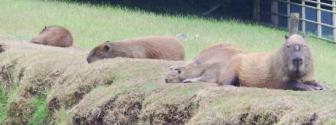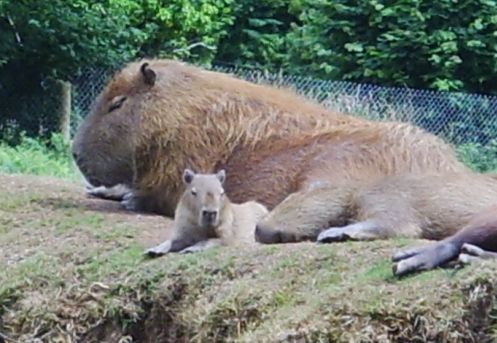Capybaras
 The capybara (Hydrochoerus hydrochaeris) also called capibara, is the largest living rodent in the world and is fairly closely related to other rodents such as chinichillas, agoutis and guinea pigs. The translation of its scientific name literally means ‘water hog’, whilst its common name means ‘master of the grasses’.
The capybara (Hydrochoerus hydrochaeris) also called capibara, is the largest living rodent in the world and is fairly closely related to other rodents such as chinichillas, agoutis and guinea pigs. The translation of its scientific name literally means ‘water hog’, whilst its common name means ‘master of the grasses’.
Adult Capybaras can reach an outstanding 4.3ft in length! They live in social groups, often between 10 and 30 capybaras in a group, although some groups of up to 100 individuals have been found.
Capybaras can often be found living near water and grassland in places such as Peru and Brazil in south America, and sometimes also in flooded savannah and tropical forests. These semi-aquatic rodents have also been sighted in Florida, although it is not sure if there is a stable population there or just one-off sightings.
 Capybaras are capable of breeding at around 22 months, but will only breed when conditions are perfect. This may be once a year or throughout the year. The gestation period lasts for approximately 140 days and the common litter consists of 4 capybara babies, although there have been single littersconsisting of between of 2 and 8 capybaras. Females will give birth on land and will rejoin the colony within a couple of hours of the birth. Her babies will join her in the water as soon as they are mobile enough to swim. Within a week of the birth, the young will beable to eat grass, but continue to suckle milk from any female in the group who is producing it. Babies are weaned at about 4 months of age.
Capybaras are capable of breeding at around 22 months, but will only breed when conditions are perfect. This may be once a year or throughout the year. The gestation period lasts for approximately 140 days and the common litter consists of 4 capybara babies, although there have been single littersconsisting of between of 2 and 8 capybaras. Females will give birth on land and will rejoin the colony within a couple of hours of the birth. Her babies will join her in the water as soon as they are mobile enough to swim. Within a week of the birth, the young will beable to eat grass, but continue to suckle milk from any female in the group who is producing it. Babies are weaned at about 4 months of age.
Did you know capybaras have quite thin fur that makes them prone to sunburn? This is the reason that they live near water and mud,as they role in it to obtain a protective layer on their skin.
The diet of the capybara is herbivorous They eat mainly grasses and water-plants, but also tree bark in some occasions and fruit.
The lifespan of a capybara is 4-8 years, although in the wild many don’t make it over 4 years of age due to the many predators these animals have: jaguars, anacondas, pumas, caiman, ocelots and eagles are just a few.
 July 24, 2010
·
July 24, 2010
·  Maddia (Admin) ·
Maddia (Admin) ·  Comments Closed
Comments Closed
 Tags: Animals, capibara, capybara, rodents, wild rodents · Posted in: Capybara
Tags: Animals, capibara, capybara, rodents, wild rodents · Posted in: Capybara


